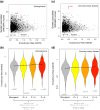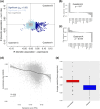Analysis of Evolutionary Conservation, Expression Level, and Genetic Association at a Genome-wide Scale Reveals Heterogeneity Across Polygenic Phenotypes
- PMID: 38865495
- PMCID: PMC11247350
- DOI: 10.1093/molbev/msae115
Analysis of Evolutionary Conservation, Expression Level, and Genetic Association at a Genome-wide Scale Reveals Heterogeneity Across Polygenic Phenotypes
Abstract
Understanding the expression level and evolutionary rate of associated genes with human polygenic diseases provides crucial insights into their disease-contributing roles. In this work, we leveraged genome-wide association studies (GWASs) to investigate the relationship between the genetic association and both the evolutionary rate (dN/dS) and expression level of human genes associated with the two polygenic diseases of schizophrenia and coronary artery disease. Our findings highlight a distinct variation in these relationships between the two diseases. Genes associated with both diseases exhibit a significantly greater variance in evolutionary rate compared to those implicated in monogenic diseases. Expanding our analyses to 4,756 complex traits in the GWAS atlas database, we unraveled distinct trait categories with a unique interplay among the evolutionary rate, expression level, and genetic association of human genes. In most polygenic traits, highly expressed genes were more associated with the polygenic phenotypes compared to lowly expressed genes. About 69% of polygenic traits displayed a negative correlation between genetic association and evolutionary rate, while approximately 30% of these traits showed a positive correlation between genetic association and evolutionary rate. Our results demonstrate the presence of a spectrum among complex traits, shaped by natural selection. Notably, at opposite ends of this spectrum, we find metabolic traits being more likely influenced by purifying selection, and immunological traits that are more likely shaped by positive selection. We further established the polygenic evolution portal (evopolygen.de) as a resource for investigating relationships and generating hypotheses in the field of human polygenic trait evolution.
Keywords: GWAS; complex traits; coronary artery disease; evolution; schizophrenia.
© The Author(s) 2024. Published by Oxford University Press on behalf of Society for Molecular Biology and Evolution.
Figures






Similar articles
-
Thinking About the Evolution of Complex Traits in the Era of Genome-Wide Association Studies.Annu Rev Genomics Hum Genet. 2019 Aug 31;20:461-493. doi: 10.1146/annurev-genom-083115-022316. Epub 2019 Jul 5. Annu Rev Genomics Hum Genet. 2019. PMID: 31283361 Review.
-
Disentangling selection on genetically correlated polygenic traits via whole-genome genealogies.Am J Hum Genet. 2021 Feb 4;108(2):219-239. doi: 10.1016/j.ajhg.2020.12.005. Epub 2021 Jan 12. Am J Hum Genet. 2021. PMID: 33440170 Free PMC article.
-
A selection pressure landscape for 870 human polygenic traits.Nat Hum Behav. 2021 Dec;5(12):1731-1743. doi: 10.1038/s41562-021-01231-4. Epub 2021 Nov 15. Nat Hum Behav. 2021. PMID: 34782732
-
A robust method to estimate regional polygenic correlation under misspecified linkage disequilibrium structure.Genet Epidemiol. 2018 Oct;42(7):636-647. doi: 10.1002/gepi.22149. Epub 2018 Aug 29. Genet Epidemiol. 2018. PMID: 30156736
-
The omnigenic model and polygenic prediction of complex traits.Am J Hum Genet. 2021 Sep 2;108(9):1558-1563. doi: 10.1016/j.ajhg.2021.07.003. Epub 2021 Jul 30. Am J Hum Genet. 2021. PMID: 34331855 Free PMC article. Review.
References
-
- Barrio-Hernandez I, Schwartzentruber J, Shrivastava A, Del-Toro N, Gonzalez A, Zhang Q, Mountjoy E, Suveges D, Ochoa D, Ghoussaini M, et al. Network expansion of genetic associations defines a pleiotropy map of human cell biology. Nat Genet. 2023:55(3):389–398. 10.1038/s41588-023-01327-9. - DOI - PMC - PubMed
MeSH terms
LinkOut - more resources
Full Text Sources
Medical

